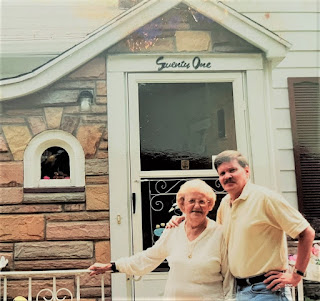 |
| Marge Bartlett with Ed Pierce in 2001. COURTESY PHOTO |
Marge was always humorous and kind and never had a bad word to say about anyone or anything. She loved to laugh and smile and was a wonderful mother whose home was filled with love.
She was married to Bob Bartlett, a glassblower at Kodak who always seemed to have a twinkle in his eye. He’d frequently demonstrate glassblowing in his workshop for my brother and me. He was a genuine craftsman and loved his work.
Along with their son Jimmy, the Bartlett’s youngest son, Kenny, was just a few months older than my sister, and that further deepened the bond between my mom and Marge. They would babysit for each other’s children on Friday nights so the other couple could go to the movies or have a night out away from the kids.
When Jimmy grew up, he went to college for broadcasting. He got married and moved to Massachusetts where he became a radio station manager and worked for the legendary sportscaster Curt Gowdy. His brother Kenny then went off to college and my sister graduated from high school and got a job and her own apartment.
That left my brother Doug and I as the ones who received the lion’s share of the attention from Marge and Bob Bartlett.
When we would visit their home, Bob seemed to have a never-ending cache of chocolate chip cookies in a jar on his kitchen counter and would ask me what I was learning about in school. Our discussions while sharing chocolate chip cookies and the questions he would ask me about my history classes seemed to spark a curiosity in me that eventually led to my career asking questions as a journalist.
Marge, on the other hand, knew precisely what a kid wanted most when they visited her home. She’d open the freezer door to her refrigerator and out would pop a small vanilla ice cream cup with strawberry or chocolate on the bottom. Of course, she’d provide the small wooden spoon to scoop out the treat.
During every visit that my brother and I would make to the Bartlett home, the freezer door would open and yet again, we’d sit on the floor in front of their black and white console television set, eating ice cream with a wooden spoon while watching an episode of “Rawhide” or “Hogan’s Heroes” on a Friday evening. I cherished the time we spent there and adored the warm hugs and encouragement that Marge and Bob would offer to us, telling us they envisioned us growing up to become movie stars, astronauts or NHL hockey players.
We also came to love their dog, Thumper, an affectionate overweight beagle whose bark sounded like an ice chest being dragged across a hardwood floor.
My brother and I did grow up and graduated from high school. I went off to college and my brother launched a career in business. My parents remained close friends with the Bartletts.
In 1982, I was serving in the U.S. Air Force in Arizona when my mother called to let me know that Bob had suddenly died from a heart attack at the age of 68. Heart disease ran in their family and the Bartlett’s son Jimmy had died of a massive heart attack at the age of 40, leaving behind a young wife and a daughter.
Through the years, whenever I returned to my hometown, I would make it a point to stop and visit with Marge. And it was like time would stand still when I did. The home I once considered to be so large was really tiny with an addition on the back that Bob had built for Marge’s mother, Sue Coleman.
The cookie jar was still on the counter and every time I’d go to see Marge, she’d open up the freezer door to the refrigerator and ask if I wanted an ice cream cup.
By this time, Marge was in her mid-80s and was losing her hearing. She also suffered from dementia and would forget to pay her electric bill. Her son Kenny or relatives living nearby would step in and pay the bill for her to keep her lights on.
Before my final visit to her home in 2001, her son Kenny implored me to see if I could talk her into moving into assisted living. I did ask and she told me she had lived in that home for 70 years and wasn’t going anywhere. Marge died in her sleep at the age of 90 in 2004 the night before Kenny’s daughter’s wedding that she was so looking forward to attending.
Last week I saw some of those ice cream cups with strawberry on the bottom at the grocery store and it reminded me of those bygone days. What I sure wouldn’t give to go back there once more. <




%20(Small)%20(Small)%20(Small).jpg)






